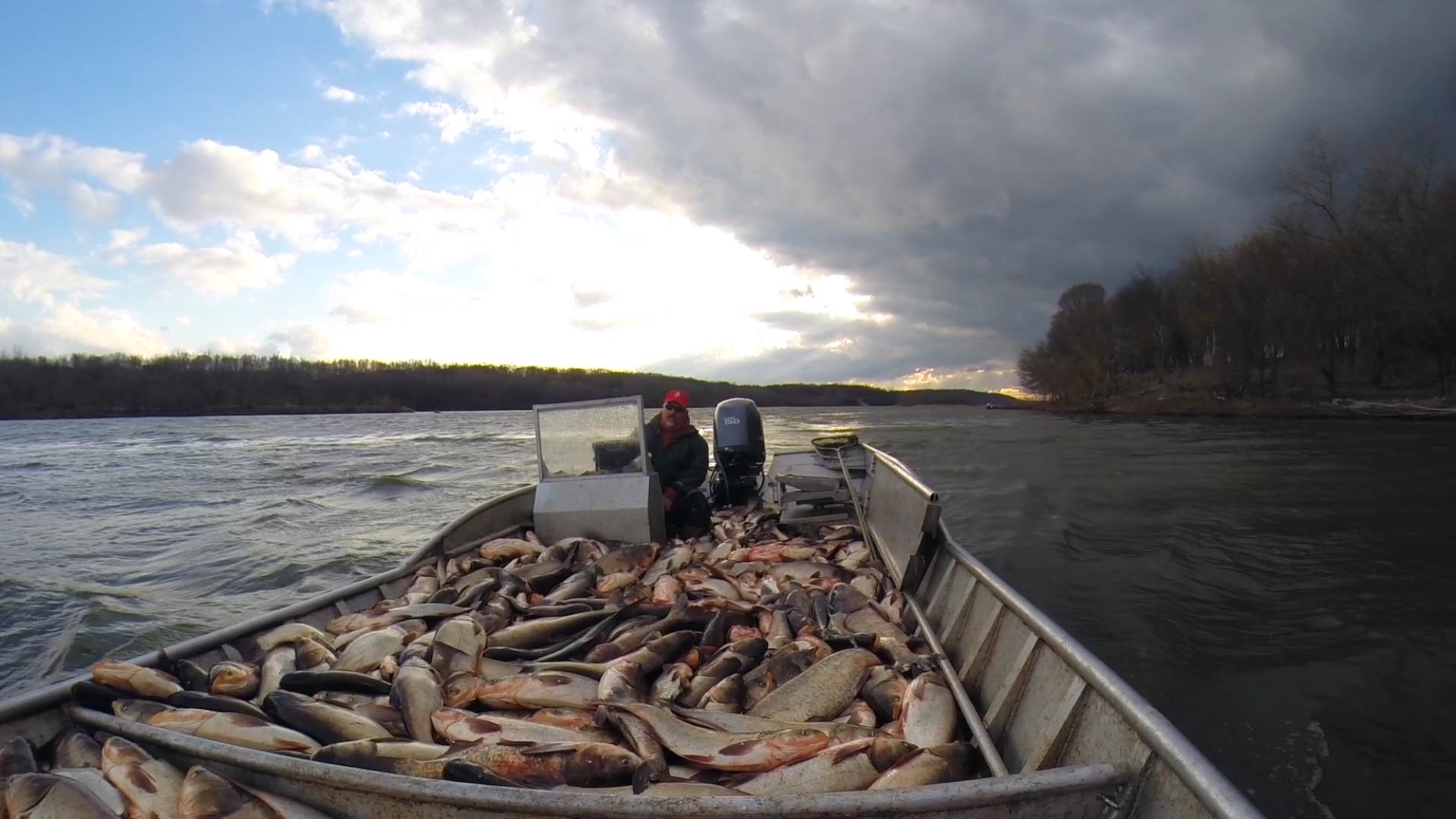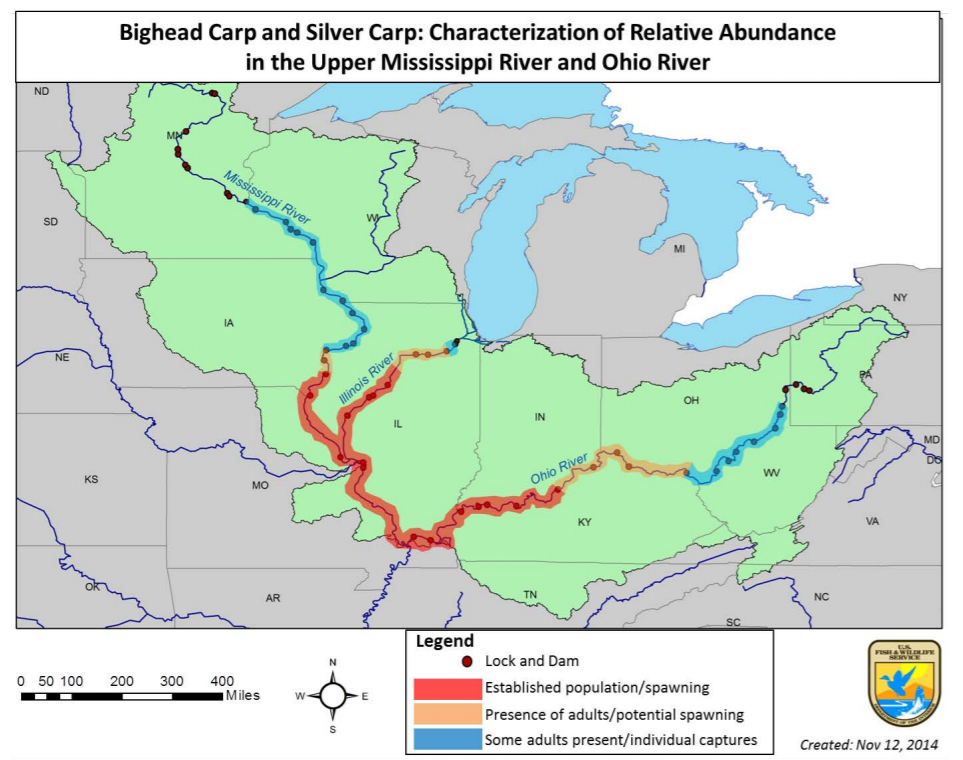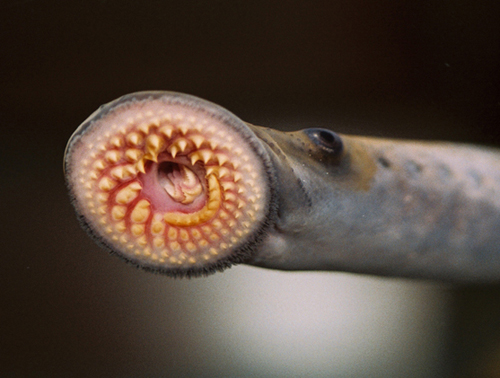
Since their introduction years ago, invasive Asian carp have infested rivers and lakes around the United States.
But they’ve been kept out of the Great Lakes — so far.
Some steps have been taken to protect the lakes system, but many believe that more effective policies — and more substantial barriers — are needed to keep the fish from spreading and to reduce the numbers where they’re already established.
In a 20-minute documentary film released today, the National Wildlife Federation visits several sites and meets people who are – and could be – impacted by the fish.
Watch the feature here:
API key not valid. Please pass a valid API key.Great Lakes Now partnered with the National Wildlife Federation for the “Carp Advance” segment that was part of our monthly show “River Influence.” You can watch that segment below.
Drew YoungeDyke, the federation’s director of conservation partnerships, spoke with Great Lakes Now about making the documentary and what some of its biggest messages are. Here is that conversation:
Great Lakes Now: How did doing a documentary about Asian carp, focusing on them as a national issue, fit with the National Wildlife Federation’s mission?
Drew YoungeDyke: The mission of the National Wildlife Federation is to unite all Americans to ensure wildlife thrive in a changing world. Part of the change happening in our waters is the introduction of invasive species like Asian carp. Our native wildlife – native fish – are being impacted as Asian carp outcompete them for food resources, resulting in less diverse aquatic ecosystems, and all the cascading effects that causes.

The National Wildlife Federation’s Drew YoungeDyke displays an Asian carp during the production of “Carp Advance,” a documentary film about the invasive fish. Photo courtesy National Wildlife Federation.
A film that educates people about the values threatened by Asian carp and the values already being impacted by Asian carp across the country is part of uniting Americans to ensure that our fisheries can thrive in this changing world. Additionally, our policy priorities as a national federation are set by our independent state affiliate organizations, which have passed policy resolutions addressing both keeping Asian carp out of the Great Lakes and reducing their numbers in the Mississippi River basin.
I’m proud that we were able to feature a few of our state affiliates working on the issue in the film – the Indiana Wildlife Federation, Prairie Rivers Network, and the Tennessee Wildlife Federation – from that national perspective.

U.S. Fish & Wildlife Service map of the spread of Asian carp.
Where are Asian carp in the Great Lakes Region? Learn more HERE in an earlier Great Lakes Now segment.
GLN: Are there still common myths or inaccuracies you hear about the invasive carp? How did you work to dispel or correct them in this film?
DY: We tried to focus on both dispelling common misconceptions as well as highlighting aspects of the Asian carp issue that garner less media attention yet are critically important. We thought it important to hear the perspective of one of the federally recognized tribes with fishing treaty rights in the Great Lakes and how Asian carp might affect them.
Sometimes we hear speculation that Asian carp wouldn’t be able to survive in the Great Lakes, so we included the perspective of a scientist who modeled food webs in the Great Lakes and how they would allow Asian carp to survive. And while a lot of attention is rightfully focused on sport fishing in the Great Lakes, we also wanted to highlight how the outdoor recreation and tourism industries would be affected by an Asian carp invasion as well as connected inland fisheries and the small business they support.
We also hear frustration sometimes that “nothing is being done about Asian carp,” so we highlighted the Eagle Marsh Berm project that was completed just a couple years ago to block a major potential pathway for Asian carp to reach the Great Lakes as well as the “block and tackle” method in Tennessee.
Finally, we wanted to focus some attention on what’s happening where Asian carp already are, because it’s not just a Great Lakes problem, it’s a national problem. We showed what it’s actually like to fish in waters invaded by Asian carp in Indiana and Tennessee, not the dramatic effect of agencies electroshocking the water but the very real feeling of trying to relax and fish with silver carp jumping randomly out of the water from all angles.
Here is other Great Lakes Now work on Asian carp:
State Struggle: Budget shortfalls stall Asian carp plan, put cleanups at risk
Study links Asian carp with Mississippi River fish drop
Asian carp caught in southwest Minnesota
Divide: Federal agencies, advocates differ on Asian carp strategy
Study: Asian carp could find plenty of food in the Great Lakes
Book Club: New book about Asian carp chronicles history, future
GLN: What were the biggest challenges in making this film?
DY: The biggest challenge was definitely shooting this film during the COVID-19 pandemic. To start, we delayed filming to comply with safety orders related to fishing guides and boat motors. We took safety precautions very seriously, both for the interviewees and the communities in which we filmed and because Jordan Browne, the filmmaker, and I both have little ones at home we want to keep safe.
National Wildlife Federation staff are under a no-travel, work-from-home policy so I had to submit and follow a detailed plan of social distancing to get travel approval to shoot the film. When I traveled to northern Michigan, Indiana, Illinois, and Tennessee for filming, I traveled alone, ate only takeout or outside, stopped only for gas, wore a mask everywhere, and kept a container of Mammoth Distilling hand sanitizer with me in the car (they actually changed over their production in the beginning of the pandemic to produce hand sanitizer, the first distillery in Michigan to do so).
I also camped out everywhere so that I didn’t have to stay in any hotels and I also scheduled the shoots to fit within just a couple long road trips to minimize my time on the road. I camped out at Sleeping Bear Dunes National Lakeshore and Barnes Park on Lake Michigan in northern Michigan and Prophetstown State Park in Indiana. We also shot everything outside and the only people on set were Jordan, me, and whoever we were interviewing, so I was also the production assistant and sometimes holding up the light shade with both hands while conducting the interview through a mask.
YoungeDyke recently appeared in a Great Lakes Now watch party. Watch that video HERE:
API key not valid. Please pass a valid API key.GLN: What do you hope audiences take away from your film?
DY: I hope they take away the understanding that Asian carp is not just an issue that affects fishing in the Great Lakes, though they certainly affect that, too. Asian carp are a national problem affecting everything from property values and tourism economies to small businesses, inland rivers and lakes, and tribal fisheries. As such, we need national solutions to stop Asian carp from invading new waters and to recover waters they’ve already invaded. I want people in the Great Lakes to support funding to help stop Asian carp down south and I want people down south to support projects like Brandon Road to keep them out of the Great Lakes.
GLN: What’s another environmental, recreation or economic issue we’ve faced that is similar to Asian carp, and how is the carp issue unique?
DY: We’ve had invasive species contribute to the collapse of the Great Lakes fishery before, with sea lamprey. It took a piscicide to be developed in the 1950s specific to sea lamprey just to somewhat control their numbers so that the fishery could recover, and then we had the stocking of non-native salmon to create the robust Great Lakes sport fishery we have now, though it’s great to see native lake trout making a comeback, too.

An up-close photo of a sea lamprey’s mouth, (Photo courtesy of GLFC)
Still, we still have to spend millions every single year in controlling sea lampreys because once you have an invasive species, you never get rid of it. The best you can hope for is to dampen their numbers enough to let native species somewhat recover. So the experience is instructive in that it’s worth even the large short-term price tag for projects like the Brandon Road Lock and Dam because it can save us the much greater cost of a collapsed fishery and millions in annual controls, even if a piscicide specific to Asian carp is ever developed, which hasn’t been done yet.
What’s unique about Asian carp is that sea lampreys don’t weigh 60 pounds and jump 10 feet out of the water. That makes Asian carp a risk not just to fishing, but to recreational boating, kayaking, stand-up paddleboarding – surfing as we showed in the film – all the things that draw people to the small towns up north that rely on tourism to sustain them throughout the year.

In this June 13, 2012, file photo, Asian carp, jolted by an electric current from a research boat, jump from the Illinois River near Havana, Ill. (AP Photo/John Flesher, File)
GLN: What do you hope we are talking about relative to Asian carp and the Great Lakes in a decade?
DY: I hope by then the Brandon Road Lock and Dam will be completed. It was 10 years ago that I wrote a law review article about the lawsuits several states brought against Illinois over Asian carp, and we’re still trying to get stronger protections in place in the Chicago Area Waterway System. My colleague Marc Smith has been working on it even longer.
A decade from now, I hope the Great Lakes and their connected waters will remain free from Asian carp, and that we’ve secured the funding necessary to keep them from moving into new waters in places like Indiana, Illinois, Kentucky, and Tennessee.
I also hope we’ve started to recover those waters already invaded by knocking down their numbers. This won’t ever be a fight we can say is over, though. We’ll always have to remain vigilant to protect our waters from Asian carp.
Here is Great Lake’s Now’s “Carp Advance” segment:
API key not valid. Please pass a valid API key.Here is an earlier segment Great Lakes Now produced about Asian carp:
API key not valid. Please pass a valid API key.Featured image: (Photo courtesy of the Illinois Department of Natural Resources)




